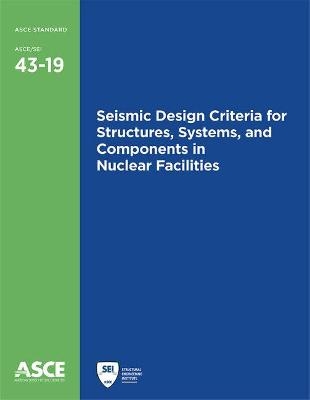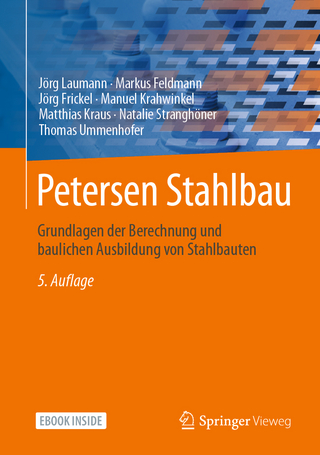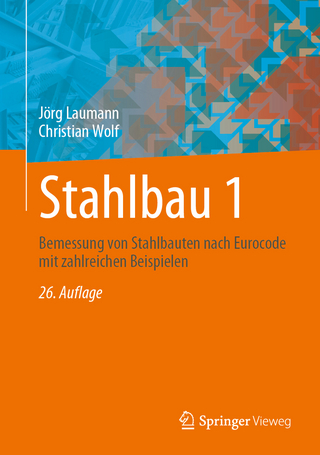
Seismic Design Criteria for Structures, Systems, and Components in Nuclear Facilities
American Society of Civil Engineers (Verlag)
978-0-7844-1540-5 (ISBN)
Prepared by the Nuclear Standards Committee and the Task Committee on Dynamic Analysis of Nuclear Structures of the Codes and Standards Activities Division of the Structural Engineering Institute of ASCESeismic Design Criteria for Structures, Systems, and Components in Nuclear Facilities provides stringent design criteria for multiple aspects associated with nuclear facilities. Because of the potential risk with nuclear hazards, nuclear facilities need to have a much lower probability than conventional facilities of sustaining structural damage caused by earthquake. The goal of this standard is to ensure that nuclear facilities can withstand the effects of earthquake ground-shaking while retaining target performance goals.
Topics include evaluation of seismic demand, evaluation of structural capacity, load combinations and acceptance criteria for structures, ductile detailing requirements, equipment and distribution systems, and seismic quality provisions. This new edition, which updates and replaces the previous edition of ASCE 43, includes a new chapter on the design of seismically isolated nuclear facilities, as well as provisions for prototype and production testing of isolators.
Standard ASCE/SEI 43-19 will be of use to engineers and analysts involved in the design and assessment of new or existing nuclear structures, systems, or components. It can also be used for facilities handling explosives, toxic materials, or chemicals; for facilities where safety, mission, or investment protection is an explicit design goal.
1. INTRODUCTION
1.1 ACRONYMS AND ABBREVIATIONS
1.2 DEFINITIONS
1.3 SEISMIC DESIGN CRITERIA
1.4 INTEGRATION OF OTHER CODES AND STANDARDS WITH ASCE 43
1.5 ALTERNATIVE METHODS TO MEET THE INTENT OF THIS STANDARD
2. EARTHQUAKE GROUND MOTION
2.1 SEISMIC HAZARD EVALUATION
2.2 DEVELOPMENT OF DESIGN BASIS EARTHQUAKE GROUND MOTIONS
2.3 METHOD TO DEFINE DESIGN RESPONSE SPECTRA AT VARIOUS DEPTHS IN THE SITE PROFILE
2.4 CRITERIA FOR DEVELOPING SYNTHETIC OR MODIFIED RECORDED ACCELERATION TIME SERIES
3. EVALUATION OF SEISMIC DEMAND
3.1 INTRODUCTION3.2 SEISMIC DEMAND DEVELOPMENT
3.3 MODELING AND INPUT PARAMETERS
3.3.1 Effective Stiffness of Reinforced Concrete and Steel-Plate Composite Wall Members
3.3.2 Mass (Effective Weight)
3.3.3 Damping Values for Structures, Systems, and Components
4. STRUCTURAL CAPACITY
4.1 STRUCTURAL SYSTEMS
4.2 COMPONENT CAPACITIES
4.2.1 General
4.2.2 Reinforced Concrete
4.2.2.1 Shear Strength of Reinforced Concrete Members
4.2.2.2 Combined In-Plane and Out-of-Plane Shear in Slabs, Diaphragms, and Walls
4.2.3 Structural Steel
4.2.4 Steel-Plate Composite
4.2.5 Reinforced Masonry
5. LOAD COMBINATIONS AND ACCEPTANCE CRITERIA FOR STRUCTURES
5.1 Load Combinations
5.1.1 General
5.1.2 Seismic Load Combinations
5.1.2.1 Seismic Load Combinations for Strength-Based Acceptance Criteria
5.1.2.2 Seismic Load Combinations for Deformation-Based Acceptance Criteria
5.1.3 Inelastic Energy Absorption Factor
5.1.3.1 Component Inelastic Energy Absorption Factor
5.1.3.2 Weak or Soft Story Inelastic Energy Absorption Factor
5.1.3.3 High-Frequency Inelastic Energy Absorption Factor
5.1.3.4 Adjustments to the Inelastic Energy Absorption Factor for Ratcheting
5.2 Acceptance Criteria
5.2.1 General
5.2.2 Strength-Based Acceptance Criteria
5.2.3 Deformation-Based Acceptance Criteria
5.2.3.1 Allowable Drift Limits for Structural Systems
5.2.3.2 Allowable Rotation Limits for Structural Members
6. DUCTILE DETAILING REQUIREMENTS
6.1 STEEL STRUCTURES
6.1.1 Moment Frames
6.1.2 Braced Frames
6.1.3 Steel-Plate Composite (SC) Shear Walls
6.1.4 Collector Elements
6.1.5 Nearly Rigid Platforms and Supports
6.2 REINFORCED CONCRETE
6.2.1 General
6.2.2 Slab-Wall Moment Frame Systems
6.2.3 Requirements for Members Not Proportioned to Resist Forces Induced by Earthquake Motions
6.2.4 Collectors
6.2.5 Joints in Floor Slabs
6.3 ANCHORAGE
7. SPECIAL CONSIDERATIONS
7.1 ROCKING AND SLIDING OF UNANCHORED BODIES
7.2 BUILDING SLIDING AND OVERTURNING
7.2.1 Building Sliding
7.2.2 Building Overturning
7.3 SEISMIC SEPARATION
7.4 SEISMIC DESIGN CONSIDERATIONS FOR FOUNDATION ELEMENTS
7.4.1 Linear Analyses
7.4.2 Nonlinear Analyses
7.4.3 Special Provisions for Foundation Components
7.4.4 Liquefaction Potential and Soil Strength Loss
7.5 UNREINFORCED MASONRY USED AS MOVABLE PARTITIONS, BARRIERS, AND RADIATION SHIELDING
7.6 PROVISIONS FOR CONSTRUCTION EFFECTS
8. SEISMIC QUALIFICATION OF EQUIPMENT AND DISTRIBUTION SYSTEMS
8.1 INTRODUCTION
8.2 QUALIFICATION BY ANALYSIS
8.2.1 Seismic Analysis Methods
8.2.1.1 Equivalent Static Analysis
8.2.1.2 Dynamic Analysis
8.2.2 Demand for Qualification by Analysis
8.2.2.1 Damping
8.2.2.2 Inelastic Energy Absorption Factor, Fµ8.2.2.3 Allowable Limit States for Active Mechanical Components and Pressure-Retaining Equipment
8.2.2.4 Total Demand for Qualification by Analysis
8.2.3 Capacity Using Qualification by Analysis
8.2.3.1 Capacity Defined by Industry Standards
8.2.3.2 Acceptance Criteria for Capacity
8.2.4 Acceptance Criteria and Documentation for Qualification by Analysis
8.3 QUALIFICATION BY TESTING AND EXPERIENCE DATA
8.3.1 Tests and Experience Methods
8.3.1.1 Testing
8.3.1.2 Test Experience Data
8.3.1.3 Earthquake Experience Data
8.3.2 Demand for Qualification by Testing and Experience Data
8.3.2.1 Demand for Qualification by Testing
8.3.2.2 Demand for Qualification by Test Experience Data and Earthquake Experience Data
8.3.3 Capacity Defined for Seismic Qualification by Testing and Experience Data
8.3.4 Acceptance Criteria and Documentation for Qualification by Tests and Experience Data
9. SEISMICALLY ISOLATED STRUCTURES
9.1 INTRODUCTION
9.2 GENERAL REQUIREMENTS
9.2.1 Isolation System
9.2.1.1 General
9.2.1.2 Vertical and Horizontal Load Resistance
9.2.1.3 Minimum Lateral Restoring Force
9.2.1.4 Wind Loads
9.2.1.5 Operating Conditions
9.2.1.6 Inspection and Replacement
9.2.2 Isolators
9.2.2.1 Mechanical Properties
9.2.2.2 Quality Assurance
9.2.3 Basemat and Foundation Designs
9.3 DISPLACEMENTS AND FORCES FOR DESIGN
9.3.1 General
9.3.2 Seismic Isolators
9.3.3 Stops
9.3.4 Structures, Systems, and Components above the Isolation Interface
9.3.5 Structures below the Isolation Interface
9.3.6 Systems and Components Crossing the Isolation Interface
9.4 PEER REVIEW
9.5 TESTING OF PROTOTYPE AND PRODUCTION ISOLATORS
9.5.1 General
9.5.2 Prototype Testing
9.5.2.1 Test Specimens
9.5.2.2 Record
9.5.2.3 Sequence and Cycles
9.5.2.4 Test Specimen Adequacy
9.5.3 Production Testing
9.5.3.1 Test Specimens
9.5.3.2 Record
9.5.3.3 Sequence and Cycles
9.5.3.4 Test Specimen Adequacy
10. QUALITY ASSURANCE PROVISIONS
10.1 DESIGN VERIFICATION AND INDEPENDENT PEER REVIEW
10.1.1 Seismic Design Verification
10.1.2 Independent Seismic Peer Review
10.2 STRUCTURAL OBSERVATION, INSPECTION, AND TESTING
10.2.1 Structural Observations10.2.2 Continuous and Periodic Inspections
10.2.3 Testing
10.3 QUALITY ASSURANCE PROGRAM
10.3.1 Design Basis Documents
10.3.2 Design Procedures
10.4 SOFTWARE QUALITY ASSURANCE
APPENDIXES
APPENDIX A. ALTERNATE METHOD TO MEET ASCE 43 PERFORMANCE GOALS WHEN SEISMIC CAPABILITIES ARE DEFINED AT THE 50% PROBABILITY OF FAILURE LEVEL
A1. INTRODUCTION
A2. SPECIFICATION OF THE DESIGN RESPONSE SPECTRUM
A3. SPECIFICATION OF MINIMUM FACTOR OF SAFETY TO BE APPLIED TO MEDIAN PROBABILITY OF FAILURE CAPABILITY
APPENDIX B. ALTERNATE METHOD TO MEET ASCE 43 PERFORMANCE GOALS WHEN SEISMIC CAPABILITIES ARE DEFINED AT THE 10% PROBABILITY OF FAILURE LEVEL
B1. INTRODUCTION
B2. SPECIFICATION OF THE DESIGN RESPONSE SPECTRUM
B3. SPECIFICATION OF MINIMUM FACTOR OF SAFETY TO BE APPLIED TO 10% PROBABILITY OF FAILURE CAPABILITY
REFERENCES
COMMENTARY TO ASCE 43-19
| Erscheinungsdatum | 15.01.2021 |
|---|---|
| Reihe/Serie | Standards |
| Verlagsort | Reston |
| Sprache | englisch |
| Maße | 229 x 254 mm |
| Gewicht | 219 g |
| Themenwelt | Technik ► Bauwesen |
| Technik ► Elektrotechnik / Energietechnik | |
| ISBN-10 | 0-7844-1540-4 / 0784415404 |
| ISBN-13 | 978-0-7844-1540-5 / 9780784415405 |
| Zustand | Neuware |
| Haben Sie eine Frage zum Produkt? |
aus dem Bereich


